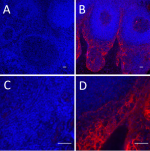- Clone
- O94E12 (See other available formats)
- Regulatory Status
- RUO
- Other Names
- Transmembrane Protein 173, MPYS, Endoplasmic Reticulum Interferon Stimulator, ERIS, MITA, NET23, and Mitochondrial Mediator of IRF3 Activation
- Isotype
- Mouse IgG2a, κ
- Ave. Rating
- Submit a Review
- Product Citations
- publications

-

Western blot analysis of cell lysates from THP-1 (positive control) and HEL (low expression negative control) cells using STING Mouse primary antibody (clone O94E12, 1:500 dilution) and HRP Goat anti-Mouse secondary antibody (Cat. No. 405306, 1:3000 dilution). Direct-Blot™ HRP anti-β-actin (Cat. No. 643807) was used as a loading control (1:8000 dilution). -

IHC staining of Purified anti-STING (TMEM173) (clone O94E12) on formalin-fixed paraffin-embedded human tonsil tissue. Following antigen retrieval using Sodium Citrate H.I.E.R., 1X (Cat. No. 928502), the tissue was incubated without (panels A and C) and with (panels B and D) 5 µg/mL of Purified anti-STING (TMEM173) (clone O94E12) followed by incubation with Alexa Fluor® 647 Goat anti-mouse IgG (Cat. No. 405322) for 1 hour at room temperature. Nuclei were counterstained with DAPI (Cat. No. 422801). Images were captured with a 10X (panels A and B) and 40X (panels C and D) objectives. Scale bar: 50 µm
| Cat # | Size | Price | Quantity Check Availability | Save | ||
|---|---|---|---|---|---|---|
| 675902 | 100 µg | 212€ | ||||
STING (TMEM173), also called stimulator of interferon genes, is a transmembrane adaptor protein that plays an important role in the innate immune response against viral and bacterial infections. It has been shown that cyclic GMP-AMP synthase (cGAS) plays a key role in STING activation. Upon activation, STING triggers downstream transcription factors STAT6 and IRF3 through TBK1 and leads to production of IFN-β. IFN-β protects infected cells and nearby cells from local infection. It is clear that chronic STING activation is involved in chronic inflammatory diseases, such as autoimmune syndromes and cancer.
Product DetailsProduct Details
- Verified Reactivity
- Human
- Antibody Type
- Monoclonal
- Host Species
- Mouse
- Immunogen
- Full length recombinant STING (TMEM173) protein produced in 293T cells.
- Formulation
- This antibody is provided in phosphate-buffered solution, pH 7.2, containing 0.09% sodium azide.
- Preparation
- Affinity purified.
- Concentration
- 0.5 mg/mL
- Storage & Handling
- Upon receipt, store undiluted between 2°C and 8°C.
- Application
-
WB - Quality tested
IHC-P - Verified - Recommended Usage
-
Each lot of this antibody is quality control tested by Western blotting. For Western blotting, the suggested use of this reagent is 1.0 - 2.0 µg/ml (1:250-1:500). For immunohistochemistry on formalin-fixed paraffin-embedded tissue sections, a concentration range of 1 - 2 µg/mL is suggested. It is recommended that the reagent be titrated for optimal performance for each application.
- Product Citations
-
- RRID
-
AB_2565608 (BioLegend Cat. No. 675902)
Antigen Details
- Structure
- A 379 amino acid protein with a predicated molecular weight around 42 kD, and observed molecular weight on SDS gel is around 35 kD.
- Distribution
-
STING is expressed in various hematopoietic cells such as T lymphocytes, NK cells, myeloid cells and monocytes and is also highly expressed in lung, ovary, heart, smooth muscle, retina, bone marrow and vagina.
- Function
- Adapter protein involved in the Toll-like receptor and IL-1 receptor signaling pathway in the innate immune response.
- Interaction
- MHC-II complex, DDX58/RIG-I, MAVS, SSR2, RNF5, TRIM56, TBK1, IFIT1 and IFIT2.
- Cell Type
- B cells, Monocytes, NK cells, T cells
- Biology Area
- Cell Biology, Immunology, Innate Immunity, Signal Transduction, Transcription Factors
- Antigen References
-
1. Lemos H, et al. 2015. Expert Rev Clin Immunol. 11:155.
2. Konno H, et al. 2014. Microbes Infect. 16:998.
3. Maringer K, et al. 2014. Cytokine Growth Factor Rev. 25:669.
4. Cai X, et al. 2014. Mol Cell. 54:289.
5. Barber GN, et al. 2014. Trends Immunol. 35:88.
6. Sun L, et al. 2013. Science. 339:786. - Gene ID
- 340061 View all products for this Gene ID
- UniProt
- View information about STING on UniProt.org
Related FAQs
Other Formats
View All STING Reagents Request Custom Conjugation| Description | Clone | Applications |
|---|---|---|
| Purified anti-STING (TMEM173) | O94E12 | WB,IHC-P |
| TotalSeq™-Bn1348 anti-STING (TMEM173) | O94E12 | SB |
Compare Data Across All Formats
This data display is provided for general comparisons between formats.
Your actual data may vary due to variations in samples, target cells, instruments and their settings, staining conditions, and other factors.
If you need assistance with selecting the best format contact our expert technical support team.
-
Purified anti-STING (TMEM173)

IHC staining of Purified anti-STING (TMEM173) (clone O94E12)... 
Western blot analysis of cell lysates from THP-1 (positive c... -
TotalSeq™-Bn1348 anti-STING (TMEM173)
 Login / Register
Login / Register 







Follow Us